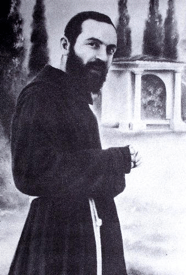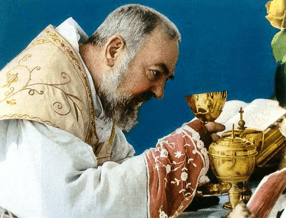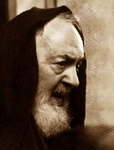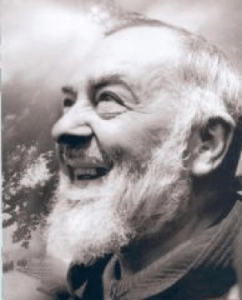Capuchin priest (1887-1968)

Padre Pio, in the world Francesco Forgione, was born in Pietrelcina, in the diocese of Benevento, on 25thMay 1887. Having entered as a cleric in the Order of Capuchin Friars Minor on 6thJanuary 1903, he was ordained a priest on 10thAugust 1910, in the cathedral of Benevento. On 28thJuly 1916, he came to San Giovanni Rotondo, on the Gargano, where, except for a few brief interruptions, he remained until his death that took place on 23rdSeptember 1968. On the morning of Friday 20thSeptember 1918, praying before the crucifix in the choir of the old church, he received the gift of the stigmata, that did not heal but bled for half a century. During his life he founded the “Prayer Groups” and a modern hospital, to which he gave the name “The Home for Relief of Suffering”. He was beatified by Saint John Paul II on 2ndMay 1999 and was canonized by him on 16thJune 2002.
Francesco Forgione was born in Pietralcina 25 May 1887, in the region of Campania. He shared the characteristics of his people: strong, direct, unpretentious. This character is one proven by the freezing winters and burning summers. It is accustomed to suffer in silence and to speak the truth to anyone, irrespective of who, and to recognise in that poor people the greatness imprinted in every child of God. That character, even if a little rough, will appear in the confessional, which under the working of grace, gave him the strength always to say things as they were, without favour or concern about how pleasing or not his observations were. He inherited a strong character from his parents, also endowed with a quick wit, skilful story tellers, and able to quickly draw an audience. His father, Grazio Maria, emigrated to both North and South America in search of work. Maria Giuseppa (“mamma Peppa”) remained at home, therefore, to bear the weight and responsibility of the family.
Francesco received the Capuchin habit in January 1903. He was still young, as was the common practice then. From that moment, everyone will know him as Fra Pio da Pietralcina. He did his novitiate at Morcone, and then began to study philosophy and theology, since he desired to be a priest. In 1908, for health reasons, he had to leave the friary, but continued to study in private. In the cathedral of Benevento he was ordained priest on 10 August 1910, on the feast of Saint Lawrence the Martyr – perhaps a portent of his long martyrdom in the years to come. Again for reasons of ill-health he had to live with his family until 1916, thus keeping alive his contact with the world of his childhood and adolescence. He fitted in perfectly with the people, speaking with them in his native dialect.
After several brief periods in the friary during those years of ‘exile’, he returned definitively on 17 February 1916. He was in the fraternity of the friary of Sant’Anna in Foggia. During those years a spiritual family was growing around him already. Each day it grew larger. He provided for this family with his talks, exhortations and, above all, a large correspondence that was interrupted some years later in obedience to ecclesial authorities. In September 1916 he was transferred temporarily to San Giovanni Rotondo for some fresh mountain air for the sake of his health. Providence, however, decided otherwise. This became ‘his’ friary where he was to remain for the rest of his life, for fifty-two years (except for a period of military service and other little parentheses.)
On 20 September 1918, he received the stigmata which he carried in his body until his death. A little more than a month later, when writing to his spiritual father, Bendetto da San Marco in Lamis, he recounted the moment. “I was in the choir after the celebration of Holy Mass. All the senses, both internal and external, and also the very faculties of the soul were in an indescribable calm … While all this was going on, I saw myself before a mysterious Person.” When this Person left Padre Pio became aware that his hands, feet and side “had been transformed and were dripping with blood.” The Person who had appeared to him was the same one who several weeks earlier, on 5 August, produced in him the transverberation, that is, the wound in his side.
Without a doubt extraordinary phenomena spread Padre Pio’s fame, but they also brought a good deal of problems. Between 1922 and 1923 he was the object of the first measures taken by the Holy Office. It declared that it did not ascertain any “supernatural character of the facts” and imposed on the friar not to celebrate Mass in public and not to answer letters sent him – either personally or through others. In 1931 he was not permitted to exercise any ministry at all, but could only celebrate Mass privately. However in 1933 he was permitted to celebrate Mass in public again and the following year his faculty to hear confessions was restored. In 1960 another apostolic visit placed new restrictions of Padre Pio. However in 1964 Cardinal Ottaviani communicated that Padre Pio could freely exercise his ministry again.
 In 1947, meanwhile, when the wounds of the war were still open, work began on building the “Casa Sollievo della Sofferenza”, opened on 5 May 1956 in the presence of Cardinal Giacomo Lercaro. On 8 May 1956 Pius XII called it “one of the best equipped hospitals in Italy.” At the same time, in spiritual support of the “Casa Sollievo” the Prayer Groups were born. These groups today are found throughout the world. Padre Pio used to say, “Without prayer our Casa Sollievo della Sofferenza is a little like a plant deprived of air and sunlight.” The fame of this austere friar grew even more – though he was not always gentle with his visitors – especially when he recognised them to be without the intentions necessary for a true journey of conversion. Huge crowds (anonymous pilgrims, show business people, learned persons …) came to San Giovanni Rotondo, full of hope and travelling that now well worn road that for centuries had been nothing more than a half abandoned mule track.
In 1947, meanwhile, when the wounds of the war were still open, work began on building the “Casa Sollievo della Sofferenza”, opened on 5 May 1956 in the presence of Cardinal Giacomo Lercaro. On 8 May 1956 Pius XII called it “one of the best equipped hospitals in Italy.” At the same time, in spiritual support of the “Casa Sollievo” the Prayer Groups were born. These groups today are found throughout the world. Padre Pio used to say, “Without prayer our Casa Sollievo della Sofferenza is a little like a plant deprived of air and sunlight.” The fame of this austere friar grew even more – though he was not always gentle with his visitors – especially when he recognised them to be without the intentions necessary for a true journey of conversion. Huge crowds (anonymous pilgrims, show business people, learned persons …) came to San Giovanni Rotondo, full of hope and travelling that now well worn road that for centuries had been nothing more than a half abandoned mule track.
When at 2.30am on 23 September 1968 Padre Pio was completely reunited with his Lord, believers and non-believers both said that a saint had died. They did not have to wait very long for his journey to sainthood to begin. On 4 November 1969 his cause for beatification was opened. On 20 March 1983 the official process began into the life and virtue of the Servant of God. The diocesan stage finished on 21 January 1990 and in 1998 a miracle was recognised in the case of Maria Consiglia De Martino of Salerno. On 21 December 1998 John Paul II published the decree on the miracle and fixed the date for the beatification as 2 May 1999. Hundreds of thousands of people came to Rome to be present for the ceremony. Millions upon millions of people throughout the world followed the rite as it was televised. This confirmed yet again the enormous veneration surrounding Padre Pio in Italy and abroad.
 What can one say about a man about whom about two hundred biographies have already been written, a man who beats every ratings record each time television dedicates a programme to one who was instrumental in the conversion of so many men and women of cinema and stage? “I will remain silent about him,” said cardinal Lecaro a while after Padre Pio’s death. “The singular facts that have concurred to draw upon this humble Capuchin in a friary in the Gargano the attention of the world: the stigmata, the mysterious perfume, the gift of prophecy, the scrutiny of hearts. I do not deny them. I do not affirm them. I leave them to the discernment and judgement of the Church. With Saint Paul I think that these gifts of the Spirit are not to make for personal greatness. All the charisms, as undeserved gits that the one Lord distributes as he wishes, are given for the good of the mystical body, that is, the ecclesial community, of which Christ is Head.” With such a completely Franciscan perspective and a calm, humble and lucid tone the cardinal thus began his talk on Padre Pio to friars, members of the prayer groups and admirers of the late Padre Pio.
What can one say about a man about whom about two hundred biographies have already been written, a man who beats every ratings record each time television dedicates a programme to one who was instrumental in the conversion of so many men and women of cinema and stage? “I will remain silent about him,” said cardinal Lecaro a while after Padre Pio’s death. “The singular facts that have concurred to draw upon this humble Capuchin in a friary in the Gargano the attention of the world: the stigmata, the mysterious perfume, the gift of prophecy, the scrutiny of hearts. I do not deny them. I do not affirm them. I leave them to the discernment and judgement of the Church. With Saint Paul I think that these gifts of the Spirit are not to make for personal greatness. All the charisms, as undeserved gits that the one Lord distributes as he wishes, are given for the good of the mystical body, that is, the ecclesial community, of which Christ is Head.” With such a completely Franciscan perspective and a calm, humble and lucid tone the cardinal thus began his talk on Padre Pio to friars, members of the prayer groups and admirers of the late Padre Pio.
After all, in his Life of Saint Francis written nearly eight centuries earlier, Thomas of Celano excused himself for not insisting too much on the miracles worked by the Saint of Assisi. He observed, did he not, that these miracles do not constitute holiness, but show it. And in 1246 did not Leo, Rufino and Angelo say the same in their letter to the Minister General, Crescenzio da Jesi, that accompanied their memoirs of Francis’ life and deeds written? Now that the Church has officially recognised his holiness, on a day that was a true grande finale, I would put to one side those prodigious facts that gained a “world-wide clientele” for Padre Pio. Instead I would prefer to dwell a moment on other aspects, aspects that are less known perhaps and less publicised. For it is precisely these which in my view reveal the strength of this humble son of Francis, a clear sign of the extraordinary flowering of holiness with which the seraphic family, in each of its branches and Orders, has enriched the Church of God in every age.
First of all, Padre Pio was a man of the confessional because he dedicated so much time to that delicate ministry, and because he was endowed with the gift of an exceptional discernment. One glance was enough for him to understand the real dispositions of the penitent and penetrate the deepest recesses of the soul – often intuiting hidden dramas; old and carefully hidden misdeeds; terrible doubts and deep questions. He knew how to read a heart accurately, and to decisively lance a wound that only the men of God know – those who only act for the glory of the Lord and for the good of souls. Certainly, he was not a man to be taken lightly, convinced as he was (and could he have been wrong?) that all of Paris has less value than one Mass.
 Truly in love with God he was a free man, immune to any human flattery, even to the point of appearing impolite and rude sometimes. A person’s status had no influence over his judgement. To everyone he said what needed to be said and could give his attention to the humblest woman even when the arrival of a princess of royal blood had been announced. (The princess was obliged to wait her turn too.) That is what happened on 12 February 1942 when the princess Maria Josè, accompanied by two ladies in waiting, arrived with all reserve in San Giovanni Rotondo. The Guardian advised Padre Pio of the illustrious visitor. He however was busy hearing confessions and calmly continued in his work. In fact, had not Saint Bonaventure of Bagnaregio done the same? When he was busy didn’t he have the papal messengers wait, those who brought his appointment as cardinal? He, the Minister General, was busy washing the dishes. Nevertheless, despite such a famous precedent, Padre Pio’s manner would cause a little problem, to the extent that he was compelled to justify himself with his superior in Foggia: “I humbly ask forgiveness”, he wrote three days later, “if I made Princess Maria Josè wait. But before her was a ordinary woman, a poor miller, who comes sometimes to confess to me. She entrusts here young children to a neighbour. Her heart is always full of anxiety for these innocent souls who are waiting minute by minute for the return of their mother. It is true, both are mothers. Both have their difficulties, but I could not leave one mother to hurry to the other. Nevertheless both approached the Lord and the good Jesus throws open his arms to welcome everyone, even those who wait and know how to wait.” Such is the extraordinary candour and freedom of the saints!
Truly in love with God he was a free man, immune to any human flattery, even to the point of appearing impolite and rude sometimes. A person’s status had no influence over his judgement. To everyone he said what needed to be said and could give his attention to the humblest woman even when the arrival of a princess of royal blood had been announced. (The princess was obliged to wait her turn too.) That is what happened on 12 February 1942 when the princess Maria Josè, accompanied by two ladies in waiting, arrived with all reserve in San Giovanni Rotondo. The Guardian advised Padre Pio of the illustrious visitor. He however was busy hearing confessions and calmly continued in his work. In fact, had not Saint Bonaventure of Bagnaregio done the same? When he was busy didn’t he have the papal messengers wait, those who brought his appointment as cardinal? He, the Minister General, was busy washing the dishes. Nevertheless, despite such a famous precedent, Padre Pio’s manner would cause a little problem, to the extent that he was compelled to justify himself with his superior in Foggia: “I humbly ask forgiveness”, he wrote three days later, “if I made Princess Maria Josè wait. But before her was a ordinary woman, a poor miller, who comes sometimes to confess to me. She entrusts here young children to a neighbour. Her heart is always full of anxiety for these innocent souls who are waiting minute by minute for the return of their mother. It is true, both are mothers. Both have their difficulties, but I could not leave one mother to hurry to the other. Nevertheless both approached the Lord and the good Jesus throws open his arms to welcome everyone, even those who wait and know how to wait.” Such is the extraordinary candour and freedom of the saints!
Finally, Padre Pio had equal love for Christ and the Spouse of Christ, the Roman Church which he always regarded as his mother, even when she caused him to suffer so much and when he could see the wrinkles on her face. When some of his devotees – who did more harm than good to him and to the cause of the Kingdom – were taken by excessive zeal and wanted to openly oppose the decisions from Rome, he reacted quickly, also without worrying too much about moderating his brusqueness: “From the profound silence of the little cell,” he wrote on 2 April 1931 to the Bihsop of Manfredonia, Andrea Cesarano –“I have heard for a little while the echo of sinister voices making themselves heard in my poor regard. I am very disgusted with the conduct of some false prophets who also call themselves mine. I have come to the point of giving them a warning .. to put an end to this false enthusiasm and to recall them to the observance of all that the Holy Office has required.” Truly a son of Francis of Assisi. He too nurtured “such faith in priests who live according to the form of the Holy Roman Church.”
It is true, in fact, that in the life of Padre Pio the marvels of the saints were repeated yet again. The saints “are not born by accident. They do not arrive by mistake. Rather, they are ‘signs’ for the situation and the time in which they live. They are ‘prophecies’ of God, that is, his judgements and teaching for our life and for our future. Therefore they re a “gift” of grace. And one does not fool about with the gifts of God. It is necessary to be worthy of them and to embrace the value and meaning of the time we have been given to live” (G. Chiaretti). Will we be able to do so?
Translation based on an article by Felice Accrocca in Sulle orme dei santi, 2000, pp. 229-238
[1] “La transverberazione (dal latino trans verberatio: da transverberare, cioè trafiggere, trapassare da parte a parte), nell’agiografia cattolica, è l’esperienza mistica attribuita ad alcuni fedeli che verrebbero feriti dall’intervento sovrannaturale di Dio o di creature angeliche.” The Italian ‘wiki’ is a more precise description than the English ‘wiki’ http://it.wikipedia.org/wiki/Transverberazione (19 June 2009).
From the letters of Saint Pio Forgione of Pietrelcina
Letters I, nn. 500 & 511
I will raise up my voice to Him strongly and I will not desist
For this reason I am led to manifest to you what happened to me on the evening of the 5th of this month and all day on the 6th.
I am quite unable to convey to you what occurred during this period of utter torment. While I was hearing the boys’ confessions on the evening of the 5th, I was suddenly terrorized by the sight of a celestial Person who presented himself to my mind’s eye. He had in his hand a sort of weapon like a very long sharp‐pointed steel blade which seemed to emit fire. At the very instant that I saw all this, I saw that Person hurl the weapon into my soul with all his might. I cried out with difficulty and felt I was dying. I asked the boy to leave because I felt ill and no longer had the strength to continue.
This agony lasted uninterruptedly until the morning of the 7th. I cannot tell you how much I suffered during this period of anguish. Even my entrails were torn and ruptured by the weapon, and nothing was spared. From that day on I have been mortally wounded. I feel in the depths of my soul a wound that is always open and which causes me continual agony.
What can I tell you in answer to your questions regarding my crucifixion? My God! What embarrassment and humiliation I suffer by being obliged to explain what you have done to this wretched creature!
On the morning of the 20th of last month, in the choir after I had celebrated Mass I yielded to a drowsiness similar to a sweet sleep. All the internal and extern senses and even the very faculties of my soul were immersed in indescribable stillness. Absolute silence surrounded and invaded me. I was suddenly filled with great peace and abandonment which effaced everything else and caused a lull in the turmoil. All this happened in a flash.
While this was taking place I saw before me a mysterious Person similar to the one I had seen on the evening of the 5th August. The only difference was that his hands and feet and side were dripping blood. This sight terrified me and what I felt at that moment is indescribable. I thought I should die and really should have died if the Lord had not intervened and strengthened my heart which was about to burst out of my chest.
The vision disappeared and I became aware that my hands, feet and side were dripping blood. Imagine the agony I experienced and continue to experience almost every day. The heart wound bleeds continually, especially from Thursday evening until Saturday. Dear Father, I am dying of pain because of the wounds and the resulting embarrassment I feel deep in my soul. I am afraid I shall bleed to death if the Lord does not hear my heartfelt supplication to relieve me of this condition. Will Jesus, who is so good, grant me this grace? Will he at least free me from the embarrassment caused by these outward signs? I will raise my voice and will not stop imploring him until in his mercy he takes away, not the wound or the pain, which is impossible since I wish to be inebriated with pain, but these outward signs which cause me such embarrassment and unbearable humiliation.
The Person of whom I spoke in a previous letter is none other than the One I mentioned having seen on the 5th August. He continues his work incessantly, causing me extreme spiritual agony. There is a continual rumbling within me like the gushing of blood.
My God! Your punishment is just and your judgment right, but grant me your mercy, Lord, with your Prophet I shall continue to repeat: O Lord, do not rebuke me in Your anger; do not punish me in your rage!
Dear Father, now that my whole interior state is known to you, do not refuse to send me a word of comfort in the midst of such severe and harsh suffering.
Prayer
Almighty and everlasting God,
you gave your priest, Saint Pio,
the singular grace of sharing
in the cross of your Son,
and by means of his ministry
you renewed the wonders of your mercy.
Grant, through his intercession,
that we may be ever joined to the Passion of Christ,
and joyously brought to the glory of his resurrection,
who lives and reigns with you and the Holy Spirit,
one God, for ever and ever. Amen.
